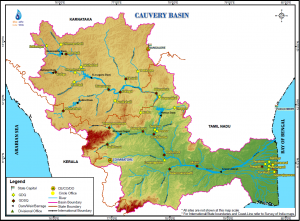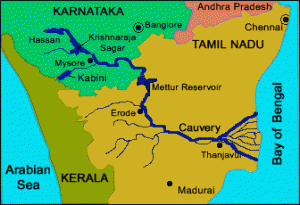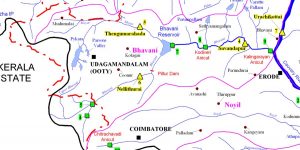<–2/”>a >Rivers are major source of Irrigation-in-tamilnadu/”>Irrigation in Tamilnadu. Let see some of major rivers that irrigates Tamilnadu. Maximum rivers in Tamil nadu are east flowing rivers and merges at Bay of Bengal.
The state receives 48% rain through the North East monsoon and 32% through the South West monsoon.
Some major rivers of the state are as under:
BHAVANI
Originates : In Palghat Ranges, Kerala
Flows Through: Erode District Of Tamil Nadu
Ultimately Joins: River Kaveri On The Salem Borders
Bhavani rises in the silent valley in Palghat ranges in the neighbouring state of Kerala, after receiving Siruvani, it flows into CoimbatoreDistrict where it gets reinforced by the Kundah River before entering Erode District in Gopichettipalaiyam.
Bhavani is more or less a perennial river fed mostly by the South West monsoon. North East monsoon also supplements its water Resources. This river runs for over hundred miles through Erode traversing through Bhavani and Gopichettipalaiyam Taluks (also spelt as Taluka). It feeds the Bhavanisagar reservoir, which takes an easterly course flowing through Gopichettipalaiyam, Satyamangalam and Bhavani Taluks, before it ultimately joins river Kaveri on the Salem borders.
Kaveri
Source : Talakaveri In Karnataka
Length: 760-kms
Coverage: Karnataka And Tamil Nadu
Main Tributaries: Bhavani, Noyil, Amaravati And Kollitam
Kaveri (also spelt as Cauvery) is among the most sacred rivers of India and is known as “the Dakshina Ganga” or “Ganga of the South”. It flows through a length of 760-kms and its main tributaries are Bhavani, Noyil, Amaravati and Kollitam.
Mythology
Mythology has several versions about Kaveri’s descent to the earth. The most popular is that a king by the name of Kavera, who lived in the Brahmagiri hills, prayed to Lord Brahma for a progeny.
He was blessed with a daughter whom he named Kaveri. She was the water manifestation of the human form. The great sage Agastya, who married her, contained her in his ‘Kamandalu’ (also spelt as Kamandal) (spouted jug). When a drought encompassed the land, Ganesha in the guise of a crow, tipped the Kamandalu and out flowed Kaveri.
Along The River
In Coorg district of Karnataka, Kaveri has its origin in Talakaveri at the height of 1,341 meters. The first dam built on this river is ” Krishnaraj Sagar ” at 19-km from Mysore where it meets with Hemawati and Laxmantirth rivers.
After 25-km from Srirangapatnam it meets Kabini and Suvarnawati rivers and near Shivsamundaram, it falls from the height of 90 metres and creates many beautiful waterfalls and springs. At 64 kms from this place, it forms the border of Karnataka and Tamil Nadu. Here, it meets with Simsa and Akrawati rivers.
In Tamil Nadu, it flows in east direction but from Hogenakkel waterfalls, it flows in south direction. At 45-km from Maitoor, it meets with its main assistant river Bhavani. When it enters into Tiruchirapalli District, it meets with Noyil and Amaravati rivers. Here it is the widest of whole of its path and hence, it is called “Akhand Kaveri”.
After Tirucharapalli, it divides into two branches. Upper branch is called ‘Kaileroon’ and falls in Bay of Bengal near Portonova. Southern branch is called ‘Kaveri’, which also falls in Bay of Bengal near Taranqubar.
Noyil
Tributary Of : Kaveri
Noted For: Capricious Nature
Irrigates: Areas In Palladam Taluk Of Coimbatore District And Dharapuram Taluk Of Erode.
Noyil River, a tributary of Kaveri is noted for its capricious nature. This is fed mostly by the Southwest monsoon but the Northeast monsoon brings rains and this very often results in floods. Inspite of its unpredictable character, the river helps to irrigate considerable areas in Palladam Taluk (also spelt as Taluka) of Coimbatore District and Dharapuram Taluk of Erode.
Cheyyar
Tributary Of : River Palar
Flows Through: Chengam Taluk Of Tiruvannamalai District
Cheyyar, Thcnpennai, Ramandala Nagu, Thurinjalaru and Suganadhi are the important seasonal rivers flowing in Tiruvannamalai district. Cheyyar is a tributary of Palar, which originates in Kolar.
River Cheyyar flows through Chengam Taluk (also spelt as Taluka) of Tiruvannamalai district. It receives rain during the Northeast and Southwest monsoon periods. Cheyyar River passes through several villages of Chengam Taluk, and is the major source of irrigation. The Taluk has different types of Soil, such as black, red loam and sandy loam. Major crops raised in the Taluk are paddy and groundnut.
Magaral lies on the northern banks of Cheyyar River. Across the river lies the Kadambarkoyil temple.
Palar
Rises In: Eastern Ghats Near Coimbatore
Flows Through: Vellore And Chingelput Districts Of Tamil Nadu
Terminates: In The Bay Of Bengal Near Caturangapattinam
Palar River rises in the Eastern Ghats near Coimbatore, runs through Vellore and Chingelput districts of Tamil Nadu and terminates into the Bay of Bengal near Caturangapattinam.
Palar River used to supply good drinking water to 30 towns on its banks and 50 villages surrounding it. The Palar river water was also used by the villagers to cultivate their land.
The Pollution Effects
Now, there are a number of tanneries on the banks of the River Palar. They let out the effluents in the Palar River. So, now the river water has been polluted and it is not useful for drinking or agricultural purposes. Due to pollution, the people are suffering from a number of diseases like asthma, skin disease and stomach ailment, etc. Thousands of acres of fertile land have become wasteland and it is not used for cultivation.
,
Tamil Nadu is a state in southern India. It is bounded by the states of Kerala to the west, Karnataka to the northwest, Andhra Pradesh to the north, and Puducherry to the northeast. The Bay of Bengal lies to the east and the Indian Ocean to the south. Tamil Nadu has a Population of over 72 million people, making it the sixth most populous state in India. The capital of Tamil Nadu is Chennai, which is also the fourth most populous city in India.
Tamil Nadu is a land of rivers. The state has over 400 rivers, of which the major ones are the Cauvery, the Kaveri, the Vaigai, the Palar, the Ponnaiyar, and the Tambraparni. The Cauvery is the longest river in Tamil Nadu and is also one of the most important rivers in India. The Kaveri originates in the Western Ghats and flows through the states of Karnataka and Tamil Nadu before emptying into the Bay of Bengal. The Vaigai originates in the Western Ghats and flows through the state of Tamil Nadu before emptying into the Bay of Bengal. The Palar originates in the Western Ghats and flows through the states of Tamil Nadu and Andhra Pradesh before emptying into the Bay of Bengal. The Ponnaiyar originates in the Western Ghats and flows through the state of Tamil Nadu before emptying into the Bay of Bengal. The Tambraparni originates in the Western Ghats and flows through the state of Tamil Nadu before emptying into the Bay of Bengal.
The rivers of Tamil Nadu are an important source of water for irrigation, drinking, and industrial use. The rivers are also a major source of hydroelectric power. The rivers are also an important part of the state’s ecosystem. The rivers provide habitat for a variety of Plants and animals. The rivers are also a popular destination for fishing, boating, and other recreational activities.
The drainage system of Tamil Nadu is a complex Network of rivers, streams, and canals. The rivers of Tamil Nadu flow into the Bay of Bengal. The drainage system of Tamil Nadu is important for the state’s economy. The rivers are used for irrigation, drinking, and industrial use. The rivers are also a major source of hydroelectric power. The drainage system of Tamil Nadu is also important for the state’s Environment. The rivers provide habitat for a variety of plants and animals. The rivers are also a popular destination for fishing, boating, and other recreational activities.
The rivers of Tamil Nadu have a significant impact on the state’s economy, environment, and Society. The rivers are used for irrigation, drinking, and industrial use. The rivers are also a major source of hydroelectric power. The rivers provide habitat for a variety of plants and animals. The rivers are also a popular destination for fishing, boating, and other recreational activities.
The rivers of Tamil Nadu are facing a number of challenges. The rivers are being polluted by industrial and agricultural waste. The rivers are also being dammed for hydroelectric power. The Dams are disrupting the flow of the rivers and are affecting the riverine Ecosystems. The rivers are also being encroached upon by human settlements. The encroachment is reducing the amount of land available for agriculture and for the rivers to flow.
The government of Tamil Nadu is taking steps to address the challenges facing the rivers. The government is implementing a number of programs to reduce pollution and to protect the riverine ecosystems. The government is also working to relocate people who have encroached upon the riverbanks.
The rivers of Tamil Nadu are an important part of the state’s economy, environment, and society. The rivers are facing a number of challenges, but the government of Tamil Nadu is taking steps to address these challenges.
Here are some frequently asked questions about Tamil Nadu rivers and drainage system part 1, along with short answers:
- What are the major rivers in Tamil Nadu?
The major rivers in Tamil Nadu are the Cauvery, the Vaigai, the Kaveri, the Palar, the Tambraparni, the Ponnaiyar, the Arani, the Amaravati, and the Vellar.
- Where do the major rivers in Tamil Nadu originate?
The Cauvery originates in the Western Ghats in Karnataka, the Vaigai originates in the Western Ghats in Madurai district, the Kaveri originates in the Western Ghats in Coimbatore district, the Palar originates in the Western Ghats in Vellore district, the Tambraparni originates in the Western Ghats in Dindigul district, the Ponnaiyar originates in the Western Ghats in Tiruvannamalai district, the Arani originates in the Eastern Ghats in Salem district, the Amaravati originates in the Eastern Ghats in Tirupattur district, and the Vellar originates in the Eastern Ghats in Tirunelveli district.
- What are the major tributaries of the major rivers in Tamil Nadu?
The major tributaries of the Cauvery are the Amaravati, the Bhavani, the Noyyal, the Pennaiyar, the Kabini, and the Hemavati. The major tributaries of the Vaigai are the Amaravati, the Vaippar, the Aiyaru, and the Manimuthar. The major tributaries of the Kaveri are the Amaravathi, the Bhavani, the Noyyal, the Pennaiyar, the Kabini, and the Hemavati. The major tributaries of the Palar are the Cheyyar, the Vaniyar, and the Ponnaiyar. The major tributaries of the Tambraparni are the Vaigai, the Aiyaru, and the Manimuthar. The major tributaries of the Ponnaiyar are the Cheyyar, the Vaniyar, and the Palar. The major tributaries of the Arani are the Amaravathi, the Bhavani, and the Noyyal. The major tributaries of the Amaravati are the Aiyaru, the Manimuthar, and the Vaigai. The major tributaries of the Vellar are the Amaravathi, the Bhavani, and the Noyyal.
- What is the drainage system of Tamil Nadu?
The drainage system of Tamil Nadu is a complex network of rivers, streams, and canals. The rivers in Tamil Nadu flow from the Western Ghats in the north to the Bay of Bengal in the south. The major rivers in Tamil Nadu are the Cauvery, the Vaigai, the Kaveri, the Palar, the Tambraparni, the Ponnaiyar, the Arani, the Amaravati, and the Vellar. The major tributaries of the major rivers in Tamil Nadu are the Amaravati, the Bhavani, the Noyyal, the Pennaiyar, the Kabini, and the Hemavati. The drainage system of Tamil Nadu is important for the irrigation of crops, the generation of hydroelectric power, and the transportation of goods and people.
- What are the environmental challenges facing the rivers and drainage system of Tamil Nadu?
The rivers and drainage system of Tamil Nadu are facing a number of environmental challenges, including pollution, deforestation, and Climate change. Pollution from industrial and agricultural activities is a major problem in the rivers of Tamil Nadu. Deforestation is leading to soil erosion and the siltation of rivers. Climate Change is causing the sea level to rise, which is threatening the coastal areas of Tamil Nadu.
- What are the conservation efforts being made to protect the rivers and drainage system of Tamil Nadu?
The government of Tamil Nadu is taking a number of steps to conserve the rivers and drainage system of the state. These steps include the construction of sewage treatment plants, the planting of trees, and the implementation of water conservation measures. The government is also working to raise awareness about the importance of protecting the environment.
Which of the following is not a river in Tamil Nadu?
(A) Cauvery
(B) Kaveri
(C) Vaigai
(D) PennarThe longest river in Tamil Nadu is the:
(A) Cauvery
(B) Kaveri
(C) Vaigai
(D) PennarThe Cauvery river originates in the:
(A) Western Ghats
(B) Eastern Ghats
(C) Nilgiris
(D) HimalayasThe Cauvery river flows through the states of:
(A) Tamil Nadu and Karnataka
(B) Tamil Nadu and Kerala
(C) Tamil Nadu and Andhra Pradesh
(D) Tamil Nadu, Karnataka, and KeralaThe Cauvery river is a major source of irrigation for the states of:
(A) Tamil Nadu and Karnataka
(B) Tamil Nadu and Kerala
(C) Tamil Nadu and Andhra Pradesh
(D) Tamil Nadu, Karnataka, and KeralaThe Vaigai river originates in the:
(A) Western Ghats
(B) Eastern Ghats
(C) Nilgiris
(D) HimalayasThe Vaigai river flows through the state of:
(A) Tamil Nadu
(B) Kerala
(C) Andhra Pradesh
(D) KarnatakaThe Vaigai river is a major source of irrigation for the state of:
(A) Tamil Nadu
(B) Kerala
(C) Andhra Pradesh
(D) KarnatakaThe Pennar river originates in the:
(A) Western Ghats
(B) Eastern Ghats
(C) Nilgiris
(D) HimalayasThe Pennar river flows through the states of:
(A) Tamil Nadu and Andhra Pradesh
(B) Tamil Nadu and Karnataka
(C) Tamil Nadu and Kerala
(D) Tamil Nadu, Karnataka, and Andhra PradeshThe Pennar river is a major source of irrigation for the states of:
(A) Tamil Nadu and Andhra Pradesh
(B) Tamil Nadu and Karnataka
(C) Tamil Nadu and Kerala
(D) Tamil Nadu, Karnataka, and Andhra PradeshThe major tributaries of the Cauvery river are:
(A) Amaravati, Bhavani, Noyyal, and Coleroon
(B) Amaravati, Bhavani, Noyyal, and Kaveri
(C) Amaravati, Bhavani, Noyyal, and Pennar
(D) Amaravati, Bhavani, Noyyal, and PalarThe major tributaries of the Vaigai river are:
(A) Amaravathi, Bhavani, Noyyal, and Coleroon
(B) Amaravathi, Bhavani, Noyyal, and Kaveri
(C) Amaravathi, Bhavani, Noyyal, and Pennar
(D) Amaravathi, Bhavani, Noyyal, and PalarThe major tributaries of the Pennar river are:
(A) Amaravati, Bhavani, Noyyal, and Coleroon
(B) Amaravathi, Bhavani, Noyyal, and Kaveri
(C) Amaravathi, Bhavani, Noyyal, and Pennar
(D) Amaravathi, Bhavani, Noyyal, and PalarThe major dams on the Cauvery river are:
(A) Mettur Dam, Kallanai Dam, and Stanley Reservoir
(B) Mettur Dam, Kallanai Dam, and Berijam Lake
(C) Mettur Dam, Kallanai Dam, and Pykara Dam
(D) Mettur Dam, Kallanai Dam, and Amaravathi DamThe major dams on the Vaigai river are:
(A) Vaigai Dam, Lower Vaigai Dam, and Periyar Dam
(B) Vaigai Dam, Lower Vaigai Dam, and Mullaperiyar Dam
(C) Vaigai Dam, Lower Vaigai Dam, and Pykara Dam
(D) Vaigai Dam, Lower Vaigai Dam, and Amaravathi DamThe major dams on the Pennar river are:
(A) Somasila Dam, Nagarjuna Sagar Dam, and Srisailam Dam
(B) Somasila Dam, Nagarjuna Sagar Dam, and Pulichintala Dam
(C) Somasila Dam, Nagarjuna Sagar Dam, and Krishna Barrage
(D) Somasila Dam, Nagarjuna Sagar Dam, and Gandikota DamThe Cauvery river is a perennial river, which means that it flows throughout the year.
(A) True

